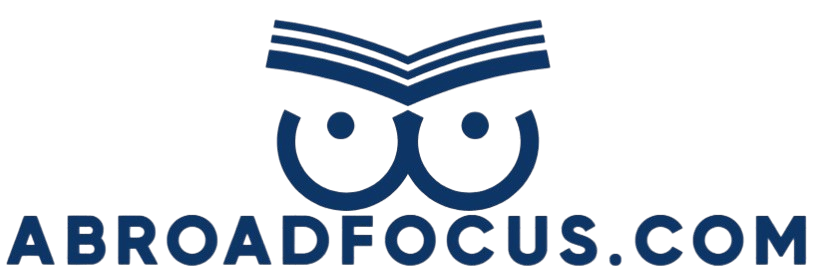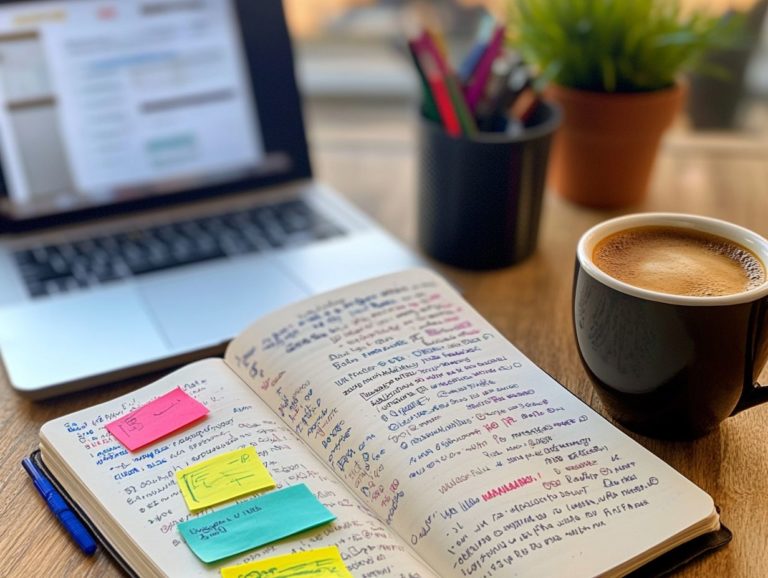5 Steps to Create a Personalized Language Learning Plan
Navigating the world of language learning can feel like an exhilarating adventure, yet it also has its overwhelming moments.
Whether you re just starting out or aiming to refine your existing skills, creating a personalized language learning plan is crucial for your success. This guide outlines five actionable steps, guiding you from assessing your current level to tracking your progress.
You ll explore the significance of a tailored approach, the myriad benefits it brings, common challenges you might encounter, and resources that will keep your motivation high.
Dive into this exciting journey to uncover how to make your language learning experience both effective and enjoyable!
Contents
- Key Takeaways:
- 1. Assess Your Current Language Level
- 2. Set Realistic Goals
- 3. Choose a Learning Method That Works for You
- 4. Incorporate Daily Practice
- 5. Track Your Progress and Adjust Your Plan Accordingly
- Why Is It Important to Create a Personalized Language Learning Plan?
- What Are the Benefits of Having a Personalized Language Learning Plan?
- How Can One Stay Motivated While Following a Personalized Language Learning Plan?
- What Are Some Common Challenges When Creating a Personalized Language Learning Plan?
- How Can One Make Their Language Learning Plan More Effective?
- What Are Some Additional Resources That Can Help with Language Learning?
- Frequently Asked Questions
Key Takeaways:
- Assess your current language level to determine where to start.
- Set realistic goals that are specific to your needs.
- Choose a learning method that keeps you engaged.

1. Assess Your Current Language Level
To embark on an effective language learning journey, it s essential for you to first assess your current language level. This evaluation will shape your study plan and help identify the specific language skills you need to focus on in order to achieve your goals. Understanding your strengths and weaknesses allows you to craft a personalized learning plan that includes clear objectives and manageable tasks, ensuring your routine is enjoyable and productive.
You can use various assessment methods to gain this insight. Consider using tests that check how well you know the language, self-evaluations that prompt personal reflection on your progress, and informal assessments like conversations with native speakers. Each of these approaches contributes to a holistic understanding of your skills.
A strong grasp of vocabulary and grammar is crucial, as these elements form the backbone of effective communication. Developing your listening comprehension will enhance your ability to engage in meaningful dialogues.
By addressing these components, you can establish a solid foundation for deeper exploration into more complex language structures and contexts.
2. Set Realistic Goals
Setting realistic language goals is essential to your learning journey. It provides both direction and motivation, ensuring your study plan is achievable and aligned with your long-term aspirations for fluent language use.
By incorporating SMART criteria, you can turn unclear goals into clear actions that yield tangible results. Instead of simply wishing to “improve vocabulary,” decide to learn 10 new words each week, measure your progress through weekly quizzes, and dedicate Fridays for review. This structured approach enhances accountability and gives you the power to track your progress over time.
Aligning your goals with personal or professional interests keeps them relevant, further fueling your commitment to the language learning journey.
3. Choose a Learning Method That Works for You
Selecting a learning method that aligns with your personal preferences and lifestyle is a crucial step in your language-learning journey. It can dramatically boost your motivation and efficiency in acquiring essential language skills, whether you choose language apps, online courses, or immersive experiences with native speakers.
Recognizing that each learner has unique needs is paramount. Exploring different methods can lead to a more enriching educational experience. For instance, interactive language apps like LingoDeer and Pimsleur offer tailored experiences that adapt to your proficiency level, making practice engaging and flexible.
Online courses provide structured learning environments that you can access at your convenience. Connecting with native speakers through language exchange helps you develop real conversational skills and cultural insights.
Incorporating engaging content like podcasts can cater to your auditory learning style, enriching your vocabulary and allowing you to absorb the language naturally.
By embracing a blend of these approaches, you can discover what resonates most with your learning style, fostering improvement and building confidence over time.
Get started today, and watch your skills soar!
4. Incorporate Daily Practice

Incorporating daily practice into your language learning routine is essential for building and maintaining your language skills. Consistent study habits can significantly enhance your speaking practice, ensure effective vocabulary review, and solidify your understanding of grammar through engaging activities.
By setting aside dedicated time each day for speaking exercises whether that s practicing with a language partner or using language exchange apps you give yourself the chance to develop the ability to hold a conversation in real-time scenarios. Daily vocabulary drills, perhaps through flashcards or interactive apps, help reinforce word retention and expand your linguistic range, enabling you to express yourself effectively.
Integrating grammar exercises into these daily sessions, whether through writing prompts or targeted quizzes, helps strengthen the structural foundation of the language. This commitment to daily practice not only boosts your confidence but also transforms language learning into a more fluid and enjoyable journey.
5. Track Your Progress and Adjust Your Plan Accordingly
Tracking your progress is an essential part of your language learning journey. It enables you to assess your advancements, hold yourself accountable, and fine-tune your study schedule for an optimized learning experience, ensuring you effectively build upon your vocabulary and language skills.
One effective approach is to keep a study journal, where you can document your daily activities, new words you encounter, and challenges you face. Utilizing language planners can also provide a structured framework, helping you organize your study sessions and set specific goals.
Setting study milestones allows you to check your progress regularly. This helps you pause and celebrate your achievements along the way. These practices not only facilitate vocabulary review but also empower you to adjust your strategies as needed, enhancing your effectiveness in mastering a new language.
Why Is It Important to Create a Personalized Language Learning Plan?
Creating a personalized language learning plan is essential for reaching your language goals. A personalized plan empowers you to learn in a way that feels exciting and natural! To effectively create your plan, consider how to set achievable language learning goals. It offers a structured approach tailored to your unique learning style, preferences, and current skills, maximizing the effectiveness of your study time and optimizing the resources at your disposal.
This individualized strategy allows you to break content into manageable segments, ensuring you absorb information without feeling overwhelmed. By recognizing that everyone has distinct strengths and challenges, this plan enhances your engagement and keeps your motivation high.
The flexibility to adapt your plan means you can include a variety of activities think conversational practice, multimedia resources, interactive games, and grammar drills (exercises designed to improve your understanding of sentence structure) ensuring a well-rounded learning experience. Ultimately, this tailored framework creates a supportive environment where you can flourish at your own pace.
What Are the Benefits of Having a Personalized Language Learning Plan?
A personalized language learning plan offers an array of benefits, from heightened motivation to improved language skills, all while allowing you to set and achieve study milestones tailored to your unique objectives. This ensures a language learning experience that is not only effective but also enjoyable and rewarding.
With this tailored approach, you can stay engaged by selecting topics and methods that truly resonate with your interests. Imagine incorporating your favorite music or films into your study sessions it makes the learning journey far more enjoyable. For example, if you’re passionate about food, you could dive into culinary vocabulary and engage in conversations about recipes, enriching your understanding of the language in a way that feels personal and relevant.
Personalized plans also foster a greater sense of accountability. By establishing specific goals and deadlines, you can track your progress and celebrate your achievements, which in turn boosts your confidence and commitment. Many successful language learners, particularly those who thrived in immersive online courses or one-on-one tutoring, often credit their success to these customized approaches. They transformed their language skills faster and more effectively than through traditional, one-size-fits-all methods.
Start your personalized language plan today and watch your skills flourish!
How Can One Stay Motivated While Following a Personalized Language Learning Plan?

Staying motivated with your language learning plan can be tough. Combine enjoyable activities with clear goals to boost your motivation!
Set exciting milestones that propel you toward fluency. Incorporating fun activities like language games, movies, or music makes the process truly enjoyable.
Connecting with accountability partners or joining language exchange programs offers vital support and helps you stay on track. Celebrate even the smallest victories, whether you ve mastered new vocabulary or held a basic conversation. Each achievement reinforces your progress and fuels your determination to keep going.
With these strategies in your toolkit, you can craft a more enriching and fulfilling language learning experience.
What Are Some Common Challenges When Creating a Personalized Language Learning Plan?
Creating a personalized language learning plan has its challenges. Common issues include setting clear objectives and managing your time well.
Many learners feel overwhelmed by the sheer volume of available resources, leading to unrealistic expectations that hinder progress. Break larger goals into smaller, actionable steps to make the journey feel less intimidating.
Implementing effective time management techniques like prioritizing tasks and scheduling regular study sessions can significantly boost your productivity.
Establishing a realistic timeline for achieving your goals provides the clarity you need. By incorporating these strategies, you can cultivate a more effective and motivating learning environment that nurtures consistent progress.
How Can One Make Their Language Learning Plan More Effective?
To make your language learning plan effective, establish a clear structure. Combine various activities and resources to cover all key skills and track your progress.
Integrate online courses tailored to different skill stages and engaging podcasts that introduce new vocabulary and expose you to various accents and cultural contexts. Exploring language exchange opportunities fosters real-world conversation practice, creating a dynamic environment for honing your speaking skills.
Stay flexible throughout this journey. Adjust your plan based on your preferences and progress to ensure your learning experience remains effective and enjoyable.
What Are Some Additional Resources That Can Help with Language Learning?
Along with traditional study methods, elevate your language learning experience by using additional resources like language apps, online courses, and access to tutors or native speakers. These tools can enhance your journey toward conversational fluency.
For instance, language apps like Mondly and Cudoo offer interactive lessons tailored to your specific skill level, making it easy to fit learning into your busy schedule. Rocket Languages provides comprehensive online courses using audio and visual materials, reinforcing what you grasp during regular practice.
Use language exchange platforms for real-time conversations with native speakers. This offers authentic practice! These diverse resources not only complement your personalized learning plan but also introduce varied methodologies, keeping your motivation high and adaptability sharp as you navigate the path to fluency.
Frequently Asked Questions

What are the 5 Steps to Create a Personalized Language Learning Plan?
Ready to dive into a new language? To create a personalized learning plan, follow these five steps: set clear goals, evaluate your current skills, figure out how you learn best, pick the right materials, and plan a study schedule.
How do I Set Language Learning Goals?
Think about which language(s) you want to learn, how fluent you aim to be, and what skills matter most to you, like speaking or writing.
Why is Evaluating My Current Skills Important?
This evaluation helps you pinpoint your strengths and weaknesses. It also allows you to track your progress and adjust your goals along the way.
How Do I Figure Out My Learning Style?
People learn in different ways: some are visual learners who benefit from images, others prefer listening, and some learn best through hands-on activities. Try various methods to see what suits you best.
What Should I Consider When Choosing Learning Materials?
Keep your goals, learning style, and current skills in mind. Select resources that align with your objectives and match how you like to learn.
How Do I Plan a Study Schedule?
Set aside specific times for your studies. Break your goals into smaller tasks, and stick to your routine. You can also use language apps or join study groups to boost your motivation.




